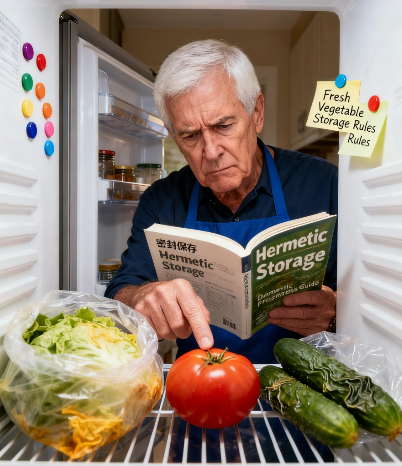
This Way of Storing Vegetables in the Fridge Makes Them Lose Most of Their…
You just returned from the farmers market or grocery store with a beautiful haul of fresh vegetables. You carefully put them away in the refrigerator, intending to nourish your body with vibrant, health-packed meals throughout the week. But by the time you reach for that crisp broccoli or those leafy greens a few days later, they’re wilted, limp, and lacking their original vitality. What happened?
The problem likely isn’t the quality of the produce you bought. The culprit is probably sitting right in your refrigerator, silently robbing your vegetables of their nutritional value and flavor. The common mistake? Storing vegetables in sealed plastic bags.
While it seems logical to keep produce sealed up tight, this well-intentioned habit is creating a hostile environment that accelerates spoilage and degrades nutrients. Here’s why that airtight plastic bag is the worst place for your veggies.
The Science of Spoilage: Why Vegetables Need to Breathe
Vegetables are living organisms. Even after they are harvested, they continue to “breathe” through a process called respiration. They take in oxygen and give off carbon dioxide, moisture, and ethylene gas (a natural ripening agent).
When you trap vegetables in a sealed plastic bag, you create a miniature, suffocating atmosphere. The oxygen inside the bag is quickly used up, and the levels of carbon dioxide and ethylene gas build up. This stressful environment causes the vegetables to deteriorate faster. The excess moisture trapped in the bag has nowhere to go, creating a humid, swampy condition that is a breeding ground for mold and bacteria, leading to rot.
But the most significant loss is in the very reason we eat vegetables in the first place: their nutrients.
The Nutrient Drain: Losing Goodness Day by Day
The vitamins and antioxidants that make vegetables so powerful are delicate compounds. They are highly susceptible to degradation from heat, light, and air. The stressful, low-oxygen environment of a sealed bag accelerates the breakdown of these precious nutrients.
- Water-Soluble Vitamins: Vitamins like Vitamin C and the B vitamins are particularly vulnerable. They leach out into the standing moisture in the bag and break down quickly. That broccoli florets can lose up to 50% or more of its Vitamin C within a week of storage, especially if it’s sitting in water.
- Antioxidants and Flavors: The compounds that give vegetables their color, flavor, and disease-fighting properties (like flavonoids and carotenoids) also degrade. This is why vegetables stored incorrectly often taste bland and look faded.
The Right Way to Store Your Vegetables for Maximum Freshness
The goal is to create an environment with balanced humidity and proper air circulation. Here’s how to do it, based on the type of vegetable:
1. For Leafy Greens (Lettuce, Spinach, Kale, Herbs):
- The Mistake: Tossing the whole plastic bag from the store directly into the crisper.
- The Solution: Treat them like a bouquet of flowers.
- Remove any tight bands or ties.
- If they seem dry, give them a quick rinse and shake off excess water (or use a salad spinner).
- Loosely wrap the greens in a single layer in a paper towel. The paper towel acts as a buffer, absorbing excess moisture while still allowing the greens to breathe.
- Place the paper-towel-wrapped bundle into a reusable, open-top container or a partially open plastic bag. This maintains humidity without creating a sealed, suffocating space.
2. For Crispy Vegetables (Broccoli, Carrots, Celery, Asparagus):
- The Mistake: Leaving them loose or in a sealed bag.
- The Solution: A little moisture goes a long way.
- For broccoli and asparagus, trim the ends and stand them upright in a jar with about an inch of water, like a vase. Loosely cover the tops with a plastic bag and store in the fridge.
- For carrots and celery, store them in a container filled with cold water. The water keeps them crisp and hydrated. Change the water every few days.
3. For Fruits That Are Treated as Vegetables (Tomatoes, Cucumbers, Peppers):
- The Mistake: Always refrigerating them.
- The Solution: In most cases, these items are best stored outside the refrigerator on the counter. Cold temperatures can damage their cell structure, making them mushy and bland. Only refrigerate them if they are very ripe and you need to extend their life for a day or two.
By making these simple adjustments, you can dramatically extend the life, crispness, and nutritional power of your vegetables. You’ll reduce food waste, save money, and most importantly, ensure that the vibrant health you’re seeking from your food is actually making it to your plate. It’s a small change in habit that pays off with every delicious, nutritious bite.